Alessandro Magnani
Semantic Retrieval at Walmart
Dec 05, 2024



Abstract:In product search, the retrieval of candidate products before re-ranking is more critical and challenging than other search like web search, especially for tail queries, which have a complex and specific search intent. In this paper, we present a hybrid system for e-commerce search deployed at Walmart that combines traditional inverted index and embedding-based neural retrieval to better answer user tail queries. Our system significantly improved the relevance of the search engine, measured by both offline and online evaluations. The improvements were achieved through a combination of different approaches. We present a new technique to train the neural model at scale. and describe how the system was deployed in production with little impact on response time. We highlight multiple learnings and practical tricks that were used in the deployment of this system.
Relevance Filtering for Embedding-based Retrieval
Aug 09, 2024



Abstract:In embedding-based retrieval, Approximate Nearest Neighbor (ANN) search enables efficient retrieval of similar items from large-scale datasets. While maximizing recall of relevant items is usually the goal of retrieval systems, a low precision may lead to a poor search experience. Unlike lexical retrieval, which inherently limits the size of the retrieved set through keyword matching, dense retrieval via ANN search has no natural cutoff. Moreover, the cosine similarity scores of embedding vectors are often optimized via contrastive or ranking losses, which make them difficult to interpret. Consequently, relying on top-K or cosine-similarity cutoff is often insufficient to filter out irrelevant results effectively. This issue is prominent in product search, where the number of relevant products is often small. This paper introduces a novel relevance filtering component (called "Cosine Adapter") for embedding-based retrieval to address this challenge. Our approach maps raw cosine similarity scores to interpretable scores using a query-dependent mapping function. We then apply a global threshold on the mapped scores to filter out irrelevant results. We are able to significantly increase the precision of the retrieved set, at the expense of a small loss of recall. The effectiveness of our approach is demonstrated through experiments on both public MS MARCO dataset and internal Walmart product search data. Furthermore, online A/B testing on the Walmart site validates the practical value of our approach in real-world e-commerce settings.
Enhancing Relevance of Embedding-based Retrieval at Walmart
Aug 09, 2024Abstract:Embedding-based neural retrieval (EBR) is an effective search retrieval method in product search for tackling the vocabulary gap between customer search queries and products. The initial launch of our EBR system at Walmart yielded significant gains in relevance and add-to-cart rates [1]. However, despite EBR generally retrieving more relevant products for reranking, we have observed numerous instances of relevance degradation. Enhancing retrieval performance is crucial, as it directly influences product reranking and affects the customer shopping experience. Factors contributing to these degradations include false positives/negatives in the training data and the inability to handle query misspellings. To address these issues, we present several approaches to further strengthen the capabilities of our EBR model in terms of retrieval relevance. We introduce a Relevance Reward Model (RRM) based on human relevance feedback. We utilize RRM to remove noise from the training data and distill it into our EBR model through a multi-objective loss. In addition, we present the techniques to increase the performance of our EBR model, such as typo-aware training, and semi-positive generation. The effectiveness of our EBR is demonstrated through offline relevance evaluation, online AB tests, and successful deployments to live production. [1] Alessandro Magnani, Feng Liu, Suthee Chaidaroon, Sachin Yadav, Praveen Reddy Suram, Ajit Puthenputhussery, Sijie Chen, Min Xie, Anirudh Kashi, Tony Lee, et al. 2022. Semantic retrieval at walmart. In Proceedings of the 28th ACM SIGKDD Conference on Knowledge Discovery and Data Mining. 3495-3503.
Large Language Models for Relevance Judgment in Product Search
Jun 01, 2024Abstract:High relevance of retrieved and re-ranked items to the search query is the cornerstone of successful product search, yet measuring relevance of items to queries is one of the most challenging tasks in product information retrieval, and quality of product search is highly influenced by the precision and scale of available relevance-labelled data. In this paper, we present an array of techniques for leveraging Large Language Models (LLMs) for automating the relevance judgment of query-item pairs (QIPs) at scale. Using a unique dataset of multi-million QIPs, annotated by human evaluators, we test and optimize hyper parameters for finetuning billion-parameter LLMs with and without Low Rank Adaption (LoRA), as well as various modes of item attribute concatenation and prompting in LLM finetuning, and consider trade offs in item attribute inclusion for quality of relevance predictions. We demonstrate considerable improvement over baselines of prior generations of LLMs, as well as off-the-shelf models, towards relevance annotations on par with the human relevance evaluators. Our findings have immediate implications for the growing field of relevance judgment automation in product search.
Overview of the TREC 2023 Product Product Search Track
Nov 15, 2023



Abstract:This is the first year of the TREC Product search track. The focus this year was the creation of a reusable collection and evaluation of the impact of the use of metadata and multi-modal data on retrieval accuracy. This year we leverage the new product search corpus, which includes contextual metadata. Our analysis shows that in the product search domain, traditional retrieval systems are highly effective and commonly outperform general-purpose pretrained embedding models. Our analysis also evaluates the impact of using simplified and metadata-enhanced collections, finding no clear trend in the impact of the expanded collection. We also see some surprising outcomes; despite their widespread adoption and competitive performance on other tasks, we find single-stage dense retrieval runs can commonly be noncompetitive or generate low-quality results both in the zero-shot and fine-tuned domain.
Quick Dense Retrievers Consume KALE: Post Training Kullback Leibler Alignment of Embeddings for Asymmetrical dual encoders
Apr 17, 2023



Abstract:In this paper, we consider the problem of improving the inference latency of language model-based dense retrieval systems by introducing structural compression and model size asymmetry between the context and query encoders. First, we investigate the impact of pre and post-training compression on the MSMARCO, Natural Questions, TriviaQA, SQUAD, and SCIFACT, finding that asymmetry in the dual encoders in dense retrieval can lead to improved inference efficiency. Knowing this, we introduce Kullback Leibler Alignment of Embeddings (KALE), an efficient and accurate method for increasing the inference efficiency of dense retrieval methods by pruning and aligning the query encoder after training. Specifically, KALE extends traditional Knowledge Distillation after bi-encoder training, allowing for effective query encoder compression without full retraining or index generation. Using KALE and asymmetric training, we can generate models which exceed the performance of DistilBERT despite having 3x faster inference.
Noise-Robust Dense Retrieval via Contrastive Alignment Post Training
Apr 10, 2023



Abstract:The success of contextual word representations and advances in neural information retrieval have made dense vector-based retrieval a standard approach for passage and document ranking. While effective and efficient, dual-encoders are brittle to variations in query distributions and noisy queries. Data augmentation can make models more robust but introduces overhead to training set generation and requires retraining and index regeneration. We present Contrastive Alignment POst Training (CAPOT), a highly efficient finetuning method that improves model robustness without requiring index regeneration, the training set optimization, or alteration. CAPOT enables robust retrieval by freezing the document encoder while the query encoder learns to align noisy queries with their unaltered root. We evaluate CAPOT noisy variants of MSMARCO, Natural Questions, and Trivia QA passage retrieval, finding CAPOT has a similar impact as data augmentation with none of its overhead.
A Multi-task Learning Framework for Product Ranking with BERT
Feb 10, 2022



Abstract:Product ranking is a crucial component for many e-commerce services. One of the major challenges in product search is the vocabulary mismatch between query and products, which may be a larger vocabulary gap problem compared to other information retrieval domains. While there is a growing collection of neural learning to match methods aimed specifically at overcoming this issue, they do not leverage the recent advances of large language models for product search. On the other hand, product ranking often deals with multiple types of engagement signals such as clicks, add-to-cart, and purchases, while most of the existing works are focused on optimizing one single metric such as click-through rate, which may suffer from data sparsity. In this work, we propose a novel end-to-end multi-task learning framework for product ranking with BERT to address the above challenges. The proposed model utilizes domain-specific BERT with fine-tuning to bridge the vocabulary gap and employs multi-task learning to optimize multiple objectives simultaneously, which yields a general end-to-end learning framework for product search. We conduct a set of comprehensive experiments on a real-world e-commerce dataset and demonstrate significant improvement of the proposed approach over the state-of-the-art baseline methods.
Image Matters: Detecting Offensive and Non-Compliant Content / Logo in Product Images
May 06, 2019
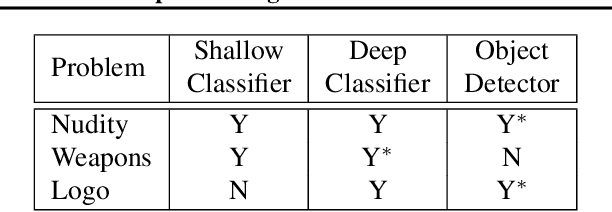

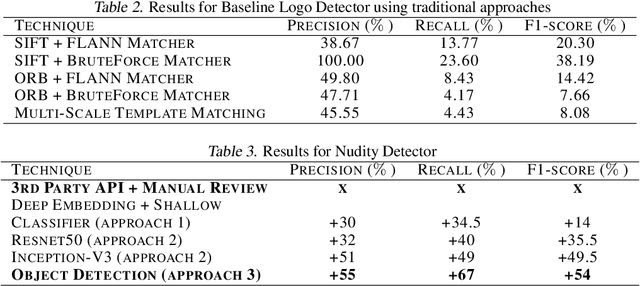
Abstract:In e-commerce, product content, especially product images have a significant influence on a customer's journey from product discovery to evaluation and finally, purchase decision. Since many e-commerce retailers sell items from other third-party marketplace sellers besides their own, the content published by both internal and external content creators needs to be monitored and enriched, wherever possible. Despite guidelines and warnings, product listings that contain offensive and non-compliant images continue to enter catalogs. Offensive and non-compliant content can include a wide range of objects, logos, and banners conveying violent, sexually explicit, racist, or promotional messages. Such images can severely damage the customer experience, lead to legal issues, and erode the company brand. In this paper, we present a machine learning driven offensive and non-compliant image detection system for extremely large e-commerce catalogs. This system proactively detects and removes such content before they are published to the customer-facing website. This paper delves into the unique challenges of applying machine learning to real-world data from retail domain with hundreds of millions of product images. We demonstrate how we resolve the issue of non-compliant content that appears across tens of thousands of product categories. We also describe how we deal with the sheer variety in which each single non-compliant scenario appears. This paper showcases a number of practical yet unique approaches such as representative training data creation that are critical to solve an extremely rarely occurring problem. In summary, our system combines state-of-the-art image classification and object detection techniques, and fine tunes them with internal data to develop a solution customized for a massive, diverse, and constantly evolving product catalog.
A Smart System for Selection of Optimal Product Images in E-Commerce
Nov 12, 2018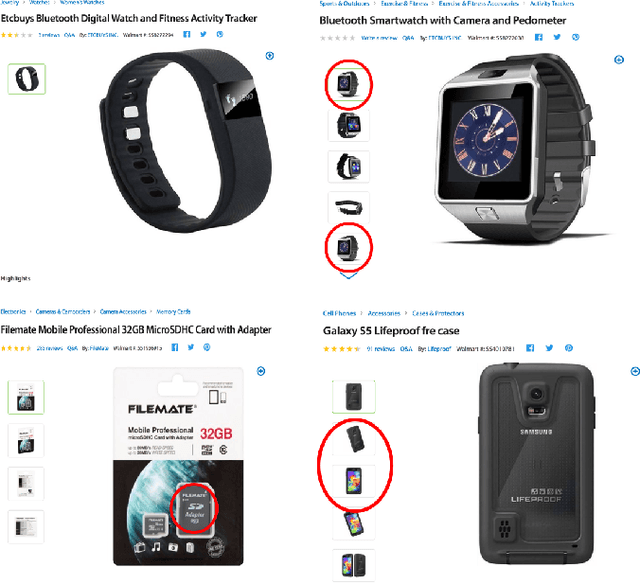
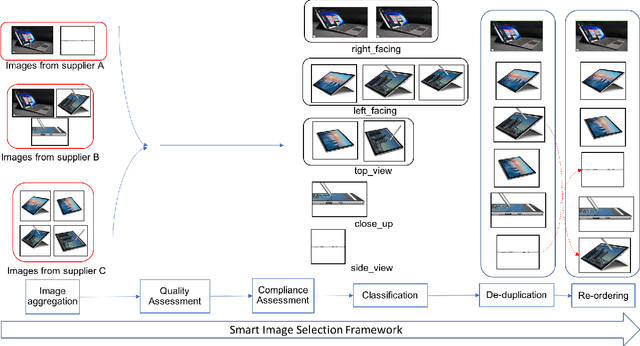
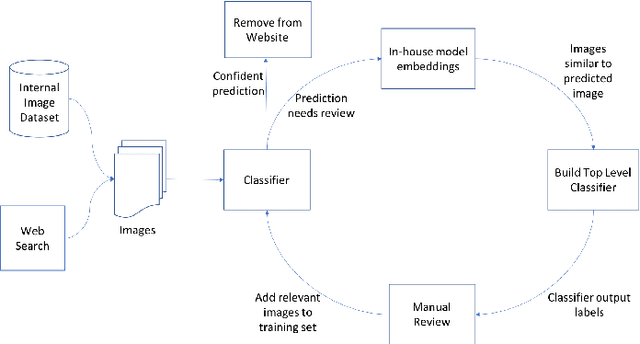
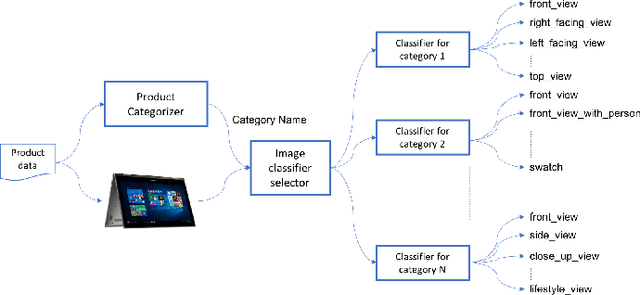
Abstract:In e-commerce, content quality of the product catalog plays a key role in delivering a satisfactory experience to the customers. In particular, visual content such as product images influences customers' engagement and purchase decisions. With the rapid growth of e-commerce and the advent of artificial intelligence, traditional content management systems are giving way to automated scalable systems. In this paper, we present a machine learning driven visual content management system for extremely large e-commerce catalogs. For a given product, the system aggregates images from various suppliers, understands and analyzes them to produce a superior image set with optimal image count and quality, and arranges them in an order tailored to the demands of the customers. The system makes use of an array of technologies, ranging from deep learning to traditional computer vision, at different stages of analysis. In this paper, we outline how the system works and discuss the unique challenges related to applying machine learning techniques to real-world data from e-commerce domain. We emphasize how we tune state-of-the-art image classification techniques to develop solutions custom made for a massive, diverse, and constantly evolving product catalog. We also provide the details of how we measure the system's impact on various customer engagement metrics.
 Add to Chrome
Add to Chrome Add to Firefox
Add to Firefox Add to Edge
Add to Edge